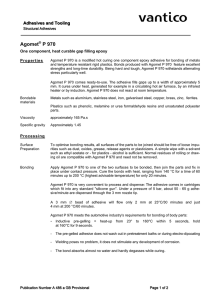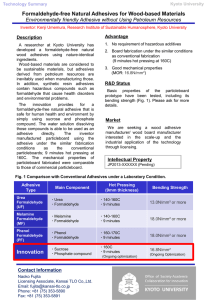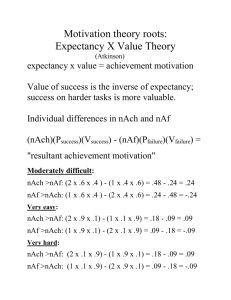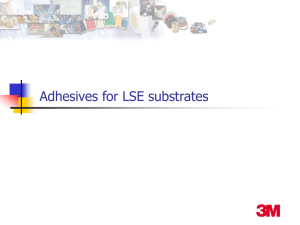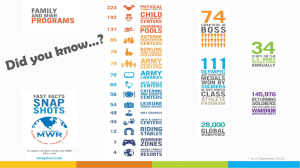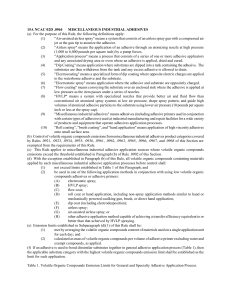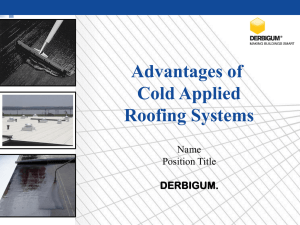Recent Advances in Soyad® Adhesives
advertisement
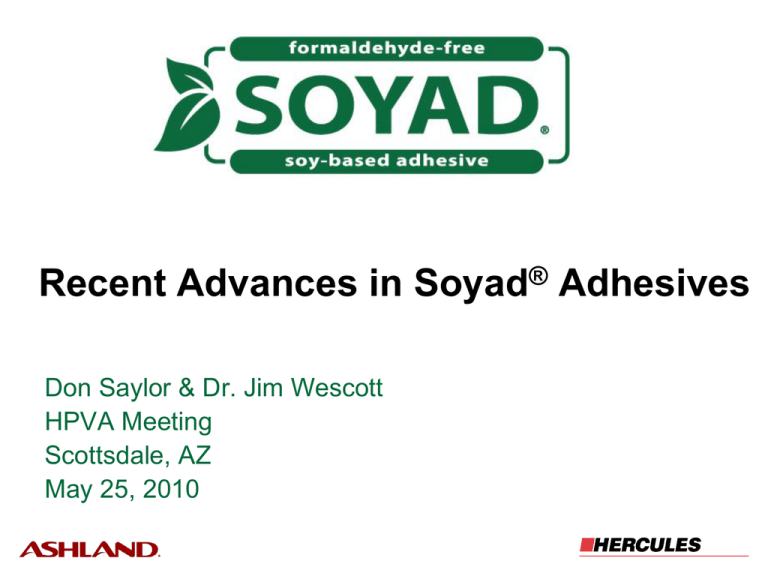
Recent Advances in Soyad® Adhesives Don Saylor & Dr. Jim Wescott HPVA Meeting Scottsdale, AZ May 25, 2010 Outline Soyad Program Development Emissions Durability Summary / Path Forward 2 5+ years of growth 14 North American HWPW-VC, HWPW-CC, & EWF mills currently manufacture with Soyad® adhesives Approximately 50% of the adhesives used to manufacture domestic HWPW & EWF stock panels are Soyad® adhesives Currently replacing over 75 million lbs of UF adhesive in HWPW & EWF annually 3 Soyad Timeline 4 Soyad® Adhesive Technology Soy Flour + Curing Resin Process and Performance Additives CROSSLINKED ADHESIVE 5 Soyad Technical Advances Higher Solids Lower Viscosity Increased Stability Adhesion Performance Modifiers Crosslinker Advancements - Lower VOC’s - New technology allows for solids >50% •Traditional Solids for paper chem 12-20% - Lower viscosity technology has been developed 6 Why Choose Soyad? 100% NAF Adhesive The most cost effective NAF option Wide operating window The Four S’s: Safe, Simple, Sticks, Stable Very easy to clean up Excellent durability- hot or cold water conditions Commitment to Excellence 7 Commitment to Excellence 600 Technical Service Chemical Engineers in NA available to support Soyad! 8 Why Choose Soyad? 100% NAF Adhesive The most cost effective NAF option Wide operating window The Four S’s: Safe, Simple, Sticks, Stable Very easy to clean up Excellent durability- hot or cold water conditions Commitment to Excellence 9 Why Choose Soyad? 100% NAF Adhesive The most cost effective NAF option Wide operating window The Four S’s: Safe, Simple, Sticks, Stable Very easy to clean up Excellent durability- hot or cold water conditions Commitment to Excellence Extremely low emissions under ALL conditions 10 Low Emissions Under ALL Conditions CARB specifies “Large Chamber ASTM E-1333” as the primary test method E-1333 is conducted at only 25 C and 50% RH - Most test are run at extremes… not this one! UF chemistry suffers from hydrolysis resulting in the GENERATION and subsequent evolution of ADDITIONAL formaldehyde 11 Emissions: Temp and Humidity Effects Static method in sealed bottles - (modified EN 717-3) Varying levels of humidity and temperature Varying durations Soyad and ULEF samples tested (Both CARB II) ¾” 7-ply HWPW Construction Study was run at and in cooperation with the Forest Products Laboratory 12 Estimated CARB P2 level < 10 ULEF Continues to generate additional CH2O ULEF at 96 hrs = 33X Soyad 13 Soyad panels emit very little additional formaldehyde after the first 24 hours ULEF rate is actually increasing exponentially (scavenger is consumed?) 14 Similar Trend at 25 C 15 Durability in EWF Stability Testing of EWF 5-Ply Engineered Wood Flooring Panels Oak/Gum/Gum/Gum/Oak construction 3/8” thickness Samples were subjected to an extreme range of temperature/humidity combinations over 15 days to probe durability Panels were cut into test pieces before beginning test protocol to maximize exposure of bond lines to environment. 3-Cycle soak samples (2” X 5”) Shear samples (1” X 3”) 17 Stability Testing of EWF Temperature/Humidity Cycling Protocol Day # Condition Time (hr) Temperature (°F) Relative Humidity Theoretical MC Pre-Test Conditioning 72 70 50% 9.2% 1 Hot/Wet 24 80 90% 20.2% 2 Cold/Moist 24 15 70% 13.5% 3 Hot/Dry 24 90 20% 4.3% 4 Cool/Wet 24 36 90% 21.0% 5 Hot/Dry 24 90 20% 4.3% Post-Test Conditioning 72 70 50% 9.2% 3X 18 Stability Testing of EWF Shear and 3-Cycle Soak Test Results Panel Testing 3-Cycle Soak Shear Strength Testing Dry Std. % Wet Std. % % Shear Dev. Dry Shear Dev. Wet Type Score Pass (psi) (psi) WF (psi) (psi) WF Control 0.81 100% 448 74 83 251 68 12 Cycled 0.38 100% 511 91 63 267 70 2 Bond lines 1 & 2 tested in shear tests (oak-gum-gum) Dimensional Stability of Shear Test Samples Length (in) Height (in) Width (in) Control Samples 3.282 0.997 0.380 Cycled Samples 3.282 0.998 0.380 19 Continued Development Desire for higher % wet wood failure - Requirement for EN-314 - Requirement for ANSI/HPVA Type I bond Lower cost system Enhanced bonding to challenging veneers - Hickory, Fumed Yellow Birch Simpler system for small veneering and assembly Desire for a lighter cured glue color 20 Summary Soyad has been accepted in North America as a high performance, low cost, no-formaldehyde alternative Soyad technology is developing rapidly Soyad emissions is a key differentiator vs. ULEF Soyad durability in EWF is excellent Soy-based NAF composite core is coming soon ! 21
